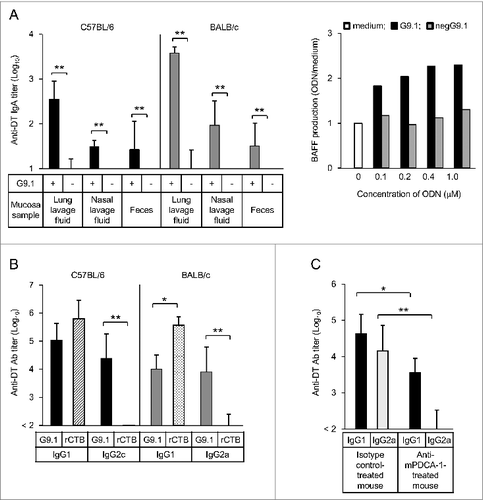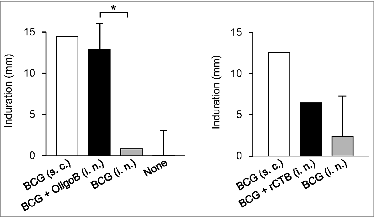Figures & data
Figure 1. G9.1 causes CD80 expression in pDCs. Human peripheral blood mononuclear cells (PBMCs) were cultured with medium alone, or with 0.8 μM of G9.1, a negative control of G9.1 (negG9.1), ODN2216, or a negative control of ODN2216 (negODN2216) for 19 hours. The numbers in the right panels represent % of CD80+ cells among plasmacytoid dendritic cells (pDCs), which were detected as CD123+HLA-DR+ cells (middle) among lineage-negative cells (left). Co-culture with negG9.1 and with negODN2216 resulted in the percentages of CD80+ cells to be 8.3% and 16.8%, respectively.

Figure 2. Nasally administered G9.1 stimulates mucosal and systemic immune responses in mice. The administration of diphtheria toxoid (DT) and G9.1 induced secretory IgA (sIgA) antibody (Ab) production in the mucosa, in conjunction with the increase of BAFF (B cell activating factor belonging to the tumor necrosis factor family) production in splenocytes (A). IgG1 and IgG2a/c Abs were also detected in serum samples, but the latter was detected only with G9.1 and not with rCTB (B). The effect of G9.1 was pDC-dependent (C). *P < 0.05 and **P < 0.01 in analysis of variance or t tests; n = 5 in (A) and (B) and n = 4 in (C). Reproduced with permission from Maeyama et al.Citation26

Figure 3. Nasally administered OligoB enhances DTH reaction to PPD. Guinea pigs were nasally immunized with BCG + OligoB or BCG + rCTB or subcutaneously immunized with BCG alone. After six weeks, a delayed-type hypersensitivity (DTH) reaction to a purified protein derivative (PPD) was evaluated. The two panels are from independent experiments. The DTH reaction induced by BCG + OligoB immunization was significantly stronger than that after immunization with BCG alone, reaching the level induced by the subcutaneous immunization with BCG. *P < 0.05 in analysis of variance followed by post hoc Tukey's test (n = 5). Reproduced with permission from Maeyama et al.Citation30,33

Figure 4. G9.1 generates a stronger IFN-α/β receptor-independent IFN-α production than ODN2216. Peripheral blood mononuclear cells (PBMCs) were cultured with 1 μM G9.1 or ODN2216 in the presence of anti-human interferon (IFN)-α/β receptor chain 2 antibody (Ab) or an isotype control (4 μg/mL, PBL Interferon Source, NJ, USA). The amount of IFN-α in the culture supernatant was measured using a multi-subtype ELISA Kit (PBL Interferon Source). **P < 0.01 in the paired t test (n = 6). Reproduced with permission from Maeyama et al.Citation26

